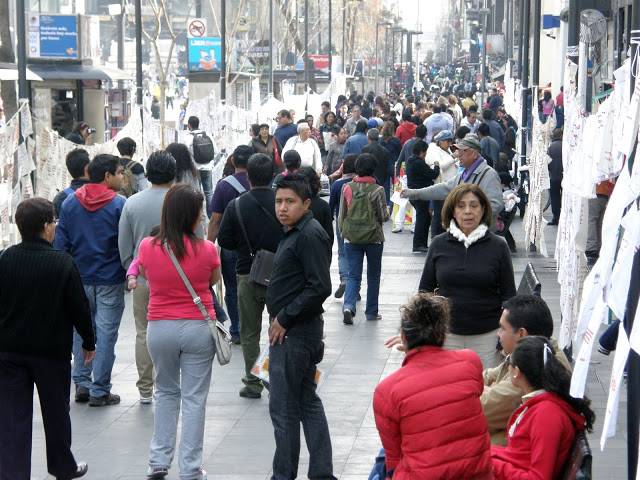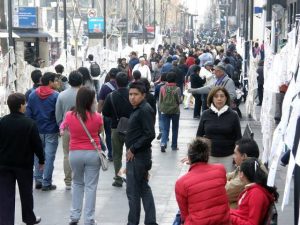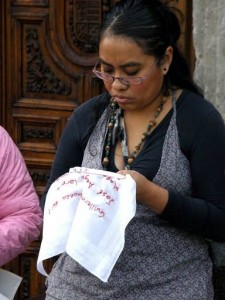Mexico’s Street Battles Reflected in Embroidered Handkerchiefs

MEXICO CITY — Elia Andrade Olea and I sit down on a bench on Avenida Juárez. She was telling me about her collective’s mission to embroider handkerchiefs, pañuelos, of the dead and missing in Mexico’s drug war. They exhibit them along two long city blocks, across the street from the Monument of Benito Juárez. It was a gripping sight. Hundreds of pedestrians stopped to read what the pañuelos said.
Elia is a lovely 35-year old. “Do a headshot,” I ask “Mexico Voices” blog editor John Reed Brundage, who is doing the photos. “Be sure to get her nose ring.”
Bordando Por La Paz, the collective Elia formed, originally planned to put its silent but moving demonstration up in the Zocalo, the national square, across the street from the National Palace. But the square was closed off to public demonstrations. President-elect Enrique Peña Nieto was to arrive there after he was sworn in as president at the Congress, across town. The Felipe Calderón administration, responsible for the drug war escalation, was now leaving office, succeeded by Peña Nieto, who was taking the constitutional oath of office before noon.
 Elia and I talked from one of the new iron benches on the sidewalk across the street from the Juarez monument where the collective’s exhibit was set up. It too was part of Alameda Park’s renovations in the cultural heart of the city.
Elia and I talked from one of the new iron benches on the sidewalk across the street from the Juarez monument where the collective’s exhibit was set up. It too was part of Alameda Park’s renovations in the cultural heart of the city.
The park had just reopened to visitors three days before, with new walkways. The gardens and greenways were replanted, trees pruned, some replaced. The several water-fountain statues and collection basins were refinished. They draw admirers by the hundreds.
Elia is founder of the Fuentes Rojas collective, their name coming from an action a year ago putting red dye in public fountains as an outcry over civilian deaths from Mexico’s drug-war escalation. “The barbarism had to end,” she reflected on that first action.
Embroidering the handkerchiefs began in August 2011, with two major public displays in the next five months. In March 2012, the embroidery, intended to attest to each individual violent death, was taken up at Parque Rojo in Guadalajara.
Then it got picked up in the neighboring state of Morelos, where people there embroidered in red and green to represent disappearances. Then people in the state of Puebla started. Nine months after the collective began, a group in the far northern border states of Coahuila and then in Nuevo Leon, began embroidering, adding text in red and a number, by then possibly 4,000 embroidered handkerchiefs had been done.
 Embroidered handkerchiefs symbolic of Mexico’s violence
Embroidered handkerchiefs symbolic of Mexico’s violence
They have as many as 90,000 to produce, accounting for “one handkerchief, one victim.” Elia reflects, “Constructing peace survives the memory of destructiveness, which comes much more rapidly.”
She had started on this mission because she felt indignant about the killing of people. “I was not at peace,” she explained.
The moral outrage and disquiet came at the time poet Javier Sicilia’s son, with six other youths, were murdered by elements connected to organized crime. She heard a reading of María Rivera’s protest poem, “The Dead,” which says: “They are called / the dead that no one knows that no one saw killed.” In the poem, Rivera objected to anonymous death, victims’ names going mostly unknown. The pañuelos intend to undo that.
This was the street battle of conscience I had expected to witness. What does a casualty to someone else’s family and friends and colleagues mean to us, the strangers, the presumed uninvolved? The embroidered handkerchief in red and green thread, is a testament to a terminated family’s life story. Each one leaves you with a haunting, unshakable, small grief of your own
Then the first explosion went off. It was like that of a muffled ceremonial canon, honoring a head of state.
Elia was telling me about the poem that compelled her on her mission when a collective member interrupted. It was better if they took down the exhibit. She said they could take it a dozen blocks away to the Monument to the Revolution.
When the second explosion went off, closer, I lost sight of Elia.
The other fight was starting. This one was not a metaphorical one over conscience but a street battle.
The crowd was now running away from the Historical District. John Reed and I went against the crowd in the opposite direction. Then the next explosion went off.
This article was first published in Voxxi.
José de la Isla, a nationally syndicated columnist for Hispanic Link and Scripps Howard news services, has been recognized during the past two consecutive years for his commentaries by New America Media. His next book, The Rise of Latino Political Power, will appear early in 2013. Reach him at joseisla3@yahoo.com.
[Photo by John Reed Brundage]

